Trafalgar defeat
September 28, 1805 Nelson led the British fleet, which blocked the Franco-Spanish fleet in Cadiz. Nelson was firmly convinced of the poor organization of French fleet, which fell into decay and, having discarded the old cautious strategy of the former naval commanders, longed for battle.
However, for the battle was necessary to exit the enemy's fleet in the open sea. It seemed unlikely that the indecisive Villeneuve, frightened by the weaker Caldera squadron, would oppose Nelson. But this problem was decided by the British Napoleon. On September 14, the French emperor ordered the Cadiz squadron to use the first favorable opportunity to break through to the Mediterranean to support the actions of the French army in Italy and create a threat to Egypt. Along the way, the allied fleet was to connect with the Spanish squadron in Cartagena (8 ships). On September 27, this instruction was received by Villeneuve, who, after the arrival of the new commander, was to hand over to him a fleet and appear in Paris "to give explanations." October 11 Villeneuve's successor, Rosili, was in Madrid. Villeneuve, to save his honor, decided to go to sea.
It is worth noting that the Spaniards at the October 19 meeting were against going to sea. The Spanish commander Antonio de Eskania offered to strengthen the defenses in the bay of Cadiz and not to try to break through the blockade of the English fleet. The Spanish admiral Gravina also categorically objected to going out to sea. First, the Spaniards noted that the crews were severely understaffed, due to the Andalusian epidemic, as a result, the ships had to take all the men from 14 to 45 to indiscriminately, who they managed to grab on the street. As a result, the crews were poorly prepared, did not want to fight. Secondly, while in Cadiz, the combined fleet is in more favorable conditions in relation to the British fleet, under the protection of coastal batteries. Third, the period of storms was approaching. On the day of the 19 meeting in October, the barometer quickly fell, indicating an approaching weather. However, the French admiral replied that the fall of the barometer should not excuse the fall of courage and allied debt.
October 19 allied squadron ships began to be removed from the anchor. Moving south to Gibraltar, early in the morning at 5 hour. 30 min., October 21, the allied fleet was 10-12 miles from Cape Trafalgar, when signalmen saw an approaching English squadron in the west. Contrary to the advice of his admirals, Villeneuve, following the old linear tactics, built his fleet in one line. Villeneuve held his flag on the 80-gun ship "Busantore" (Fr. Bucentaure). The Allies had 33 battleships, 5 frigates, 2 sloop with crew in 20 thousand, and 2864 guns.
For a while Villeneuve hesitated whether to accept the battle or return. Around 8 hour. In the morning, Villeneuve ordered his ships to make a “Fordewind turn, all of a sudden, a north course, in reverse order,” and move back to Cadiz. This meant that the avant-garde was becoming a rearguard. K 10 hour. The turn has been completed. Such a maneuver before the start of the battle upset the battle order of the Allies, dangerous ruptures of the distance appeared in the ranks of ships, and some ships, in order not to collide with their neighbor, were forced to “fall out”. By the time of the engagement, the Allied fleet did not have time to line up in an ideal wake formation, when the sailing ship next protects the stern ahead. The line of allies was a crescent, curved to the right, toward the mainland.
Taking into account the weather, Nelson decided to abandon the classic linear tactics and built his ships in two columns (divisions). The admiral's flag was hoisted on the Victory 104 cannon battleship. This ship was heading in the left column. Right-wing convoy was led by Rear Admiral Cuthbert Collingwood on the 100-gun ship "Royal Sovereign". The British had 27 battleships, a 4 frigate and a 2 sloop with crew in 16 thousand people and 2312 guns.
Collingwood with 15 ships was to attack the Allied rearguard - 12 ships and destroy it as quickly as possible. Meanwhile, another convoy commanded by Nelson himself (12 ships) was to bind the main forces of the Allies with battle so that the center of their military formation could not assist the rearguard. At the same time, Nelson gave the captains considerable freedom to take the initiative: “If you don’t see signals in battle or if you don’t understand them, put your ship next to the enemy - you will not go wrong.”
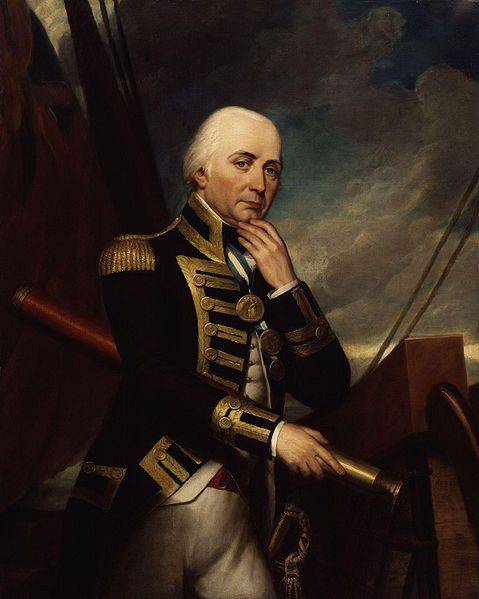
British admiral Cuthbert Collingwood
Before the battle began, making sure that everything was going as planned, and Collingwood’s column had already begun to draw closer to the enemy, Nelson made the last entry in his diary: “God Almighty favor God to bestow England a complete and glorious victory. May He not allow a single private weakness to darken the brilliance of it, and let the British fleet not forget the sacred duty of humanity! As for myself, my life is in the hands of Him Who bestowed it on me. May He bless my efforts to serve the Fatherland faithfully! To his will, I commit myself and a just cause, the protection of which is entrusted to me. ” About 12 hour. Day Nelson ordered to raise the signal for the British squadron: "Nelson believes that everyone will do their duty." However, such a signal was impossible to raise - the code did not have the necessary designations; then the original formula turned into the famous: "England is waiting for everyone to do their duty."
Soon after 11 an hour. came the first volley of the Battle of Trafalgar. The Spanish 112-gun ship “Santa Ana” opened fire on Collingwood’s flagship. Following this, other Allied ships opened fire. About 12 hour. 30 min. Collingwood's ship cut through enemy lines and for some time found itself alone in the midst of French and Spanish ships. For more than a quarter of an hour the British ship fought alone, since the rest of the ships could not come up for support due to the weak wind. The flagship was badly damaged.
Soon, other ships of the right column entered the battle, and about 1 an hour. Nelson’s column entered the fray. "Victory" broke through the enemy column between the largest ship of the XVIII century. Spanish 144-gun "Holy Trinity" (Santisima Trinidad) and the French flagship. I must say, the Spanish "Trinity" was the world's first four-deck ship with a crew of 1200 people. The British had more skillful crews and gunners: on average, three volleys of Englishmen followed each salvo of the French and the Spaniards (French historians cite the ratio of the rate of shooting 7 / 4). British ships, breaking through the structure of the enemy, fired from two sides. At the same time, the British gunners tried to hit the enemy’s cannon ports in order to disable their artillery.
The allies did not use the odds that gave them the opportunity to cause serious damage to the enemy. Thus, because of the weak wind, the British ships engaged in battle with a large time interval, which made it possible for the allies to attack enemy ships separately. But indecision and low cohesion did not allow the allies to use this opportunity. Moreover, the Allied vanguard, under the command of Admiral Pierre Dumanoir, on the Formidable flagship of the vanguard, broke away from the central grouping, and, disregarding the signals from Villeneuve, continued to go to Cadiz. Dumanoir took with him nine ships of the avant-garde and one ship joined the avant-garde from the central group. As a result, at the most decisive moment, the admiral did not assist the main forces, left the scene of the battle, instead of fighting further. Only in 15 hour. the avant-garde ships began to turn, but approached the battlefield in separate groups and could not provide effective assistance to the center. A few French ships in general have passed the fight.
Thus, the British flagships Royal Soverein and Victory, at the head of their columns, attacked the center of the wake line of the French-Spanish fleet, while the ships of the second column fought with the rearguard and the first with the center of the enemy. For some time the lead ships of the columns were in the ring of fire, but then they were supported by the rest of the ships. The ships of the center of the allied fleet, trapped between two British columns, mixed up and were forced to take the battle, in which the British fleet had a numerical advantage. Given the best skills of British gunners, who fired shots per minute, while the French - one in three minutes, the defeat of the allies became apparent.
The presence on the deck of Nelson with all the regalia podzadoril French shooters. The admiral did not pay attention to the entreaties to come down and paid for it. When the Victory entered the boarding battle with the French ship Redoutable (Redoutable), one of the French riflemen fired an accurate shot - the bullet went through an epaulette, punched a light shoulder and got stuck in the back of the British commander. The mortally wounded Nelson, who was carried to the infirmary, was still alive and demanded a report on the progress of the battle. At 4 hours, the victorious commander Hardy approached Nelson, saying that the enemy's 15 had already been taken and the battle was won, to which the admiral replied: "This is good, but I was counting on 20." Hardy remarked that now that the battle was won, Lord Collingwood could well take over the command, but Nelson responded with a categorical refusal, intending to fight to the end. The naval commander died at the 16 hour. 30 min., Received before the death report on the complete victory of the English fleet.
The Allies suffered a defeat. The center ships and some of the French-Spanish rearguard ships were surrounded and began to lower the flags. About 14 hour. lowered the flag flagship Villeneuve "Bussantor". The French ship lost all the masts. Nelson's ship aboard the French Redoubt. The French fought fiercely and surrendered only after they lost the 80% crew. The huge Spanish "Trinity" fought with 7 British ships and was captured.
Resolutely and bravely on this day the commander of the Allied rearguard, the Spanish admiral Gravina, who was on the Prispe de Asturias 112-gun ship, acted. He showed tremendous personal courage. In this battle, Gravina lost a hand that she had shattered the canister. Despite the injury, the naval commander continued to lead the battle. Admiral Federico Gravina, used the mistake of Collingwood, who, at the head of the ships breaking through the enemy, rushed after the Allied vanguard ships moving towards Cadiz, instead of hitting heavily damaged rear-guard ships. Gravina raised the “Follow Me” signal and saved several heavily damaged ships that had lost a lot of people from English captivity. He took the ships to Cadiz.
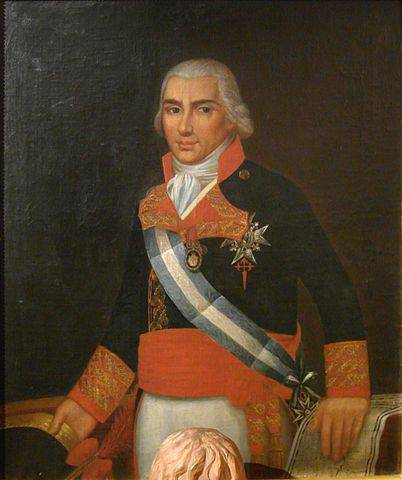
Spanish admiral Federico Gravina
October 22 Gravina, having covered the ships in the bay of Cadiz from the storm, hastily repairs them. On this day, several ships destroyed elements. Thus, the "Holy Trinity" sank, which the British tried to tow England to repair. October 23 Gravina again displays combat-ready ships at sea, to discourage the ships they captured from the British, to try to save crews from ships that have lost their course and control. As a result of this attack, the Santa Ana was repulsed, but the storm destroyed two ships.
4 November 1805 The British squadron of Captain Richard Strachen captured the French squadron of Rear Admiral Pierre Dumanoir, who slipped away from Trafalgar. After several hours of fierce battle at Cape Ortegal Strecen forced the French ships to surrender. All four captured ships were sent to the UK as prizes. This victory completed the rout of the French fleet, begun by the victory of Nelson at Trafalgar.
The Battle of Cape Ortegal
Results
In the Battle of Trafalgar, the British captured 17 ships as a prize, one more burned out. After the ships of Dumanuar were caught near Cape Ortegal, the Allied losses reached the 22 ships. The Allies lost about 15 thousands of people killed, wounded and surrendered (according to other sources - about 7 thousand people). The British lost about 2 thousand people. True, many British ships were badly damaged. The French admiral Sh. R. Magon, the commander of the rearguard, died in battle. The Spanish flagship K. Gravina soon died of wounds. Villeneuve was captured, took part in the solemn ceremony of the funeral of Nelson, and on his return to France, committed suicide (or was killed).
The British victory was caused by a number of reasons: this is the general decline of the French fleet; the lack of a unified strategy among the allies, and this led to the fact that they acted as separate detachments, could not use the mistakes of the enemy in order to cause him at least a lot of damage; the flexibility of the English command, abandoned the linear tactics, considerable freedom in decision-making and the initiative of the captains of individual ships; the best training of English crews; in general, much better motivation of the British. Villeneuve engaged in battle with disgruntled allies, who were annoyed by the fact that the French were in control of Spain, with ships, many of which had not yet been at sea, with officers, whose trust he had lost, with gunners, who for the most part had never cannons from the swinging deck.
The strategic results of this battle were enormous. The French fleet was almost completely destroyed. The victory ensured the domination of the British fleet at sea, which hampered the connection of France with its colonies. Napoleon abandoned his plans for landing troops in England and invading the Neapolitan kingdom. France and Spain forever ceded the seas and oceans of England. Britain for a long time acquired the status of "mistress of the seas", putting an end to a long struggle on the seas with Spain, Holland, Denmark and France.
The memory of the Battle of Trafalgar was preserved in England. Nelson became a national hero. Nelson’s name invariably figures among the top ten in Air Force polls for the great Britons and their contribution to history and the culture of England. In 1830, in the very center of London, Trafalgar Square was created according to a design by the builder of Buckingham Palace, architect J. Nash. In 1842, a monument to Admiral Lord Nelson was erected in the center of the square - a column of three human height on a pedestal of 50 meters in height, guarded by bronze lions - symbols of the power of the British Empire. This column went 16 tons of copper from the melted French guns taken in the Battle of Trafalgar. The flagship of the British fleet, the Victory, was also immortalized - it was put on a perpetual joke in the second dry dock of the Portsmouth naval base. The ship initially remained the flagship of the Second Sea Lord, and then became an exhibit of the Museum of the Royal Navy.
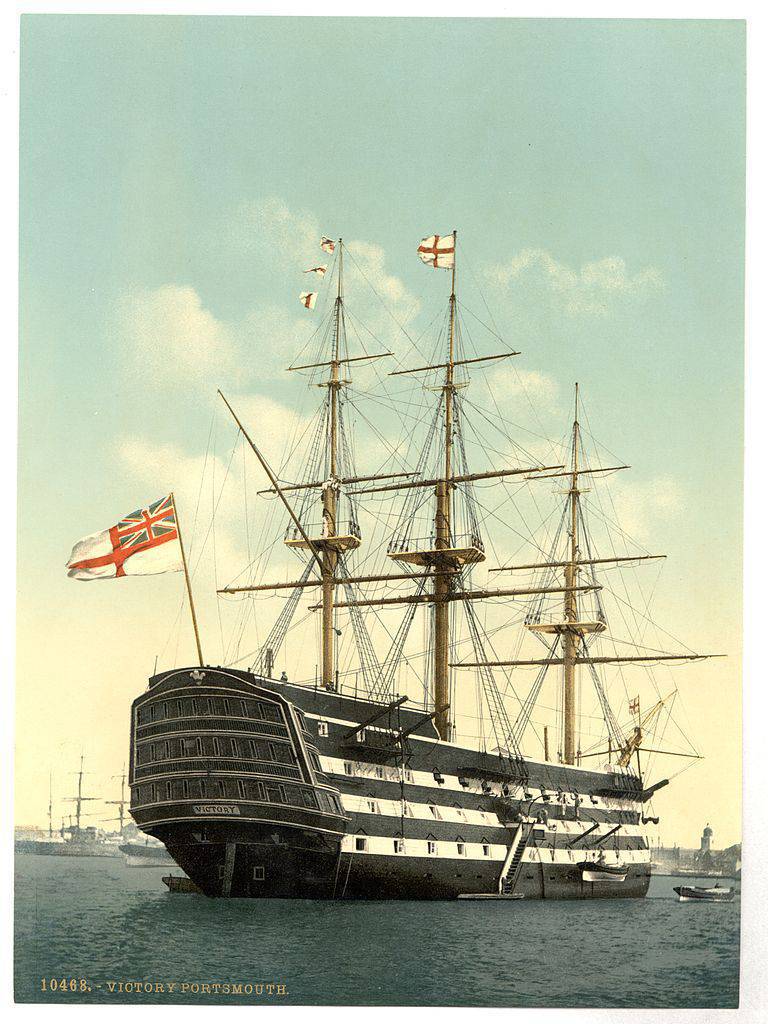
Ship "Victory"
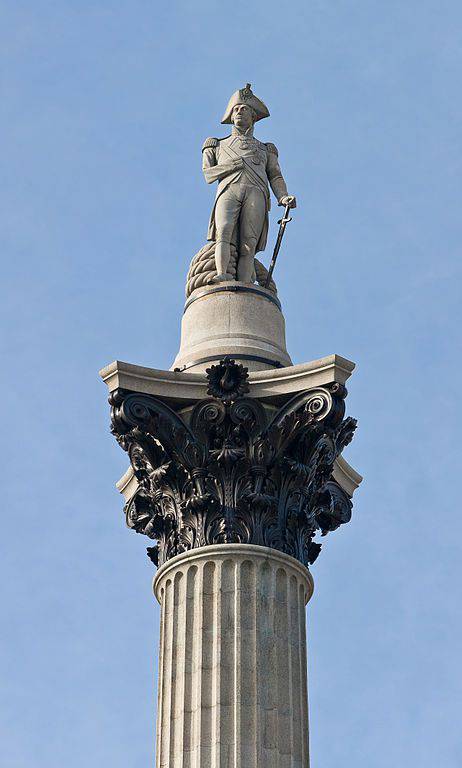
Nelson's Column on Trafalgar Square in central London
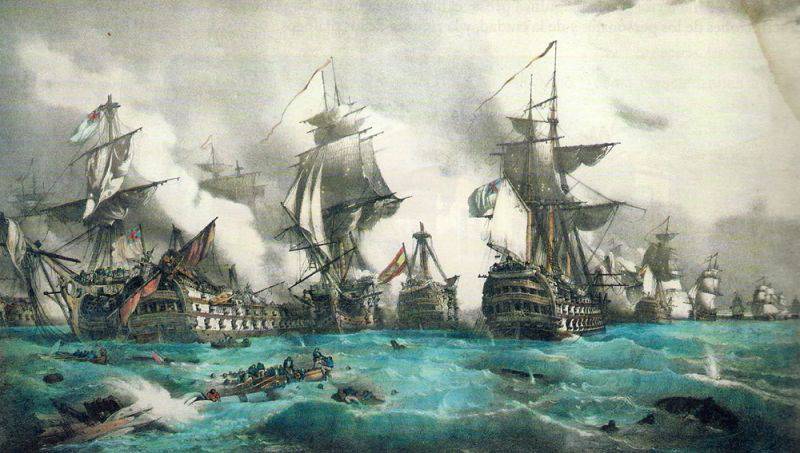
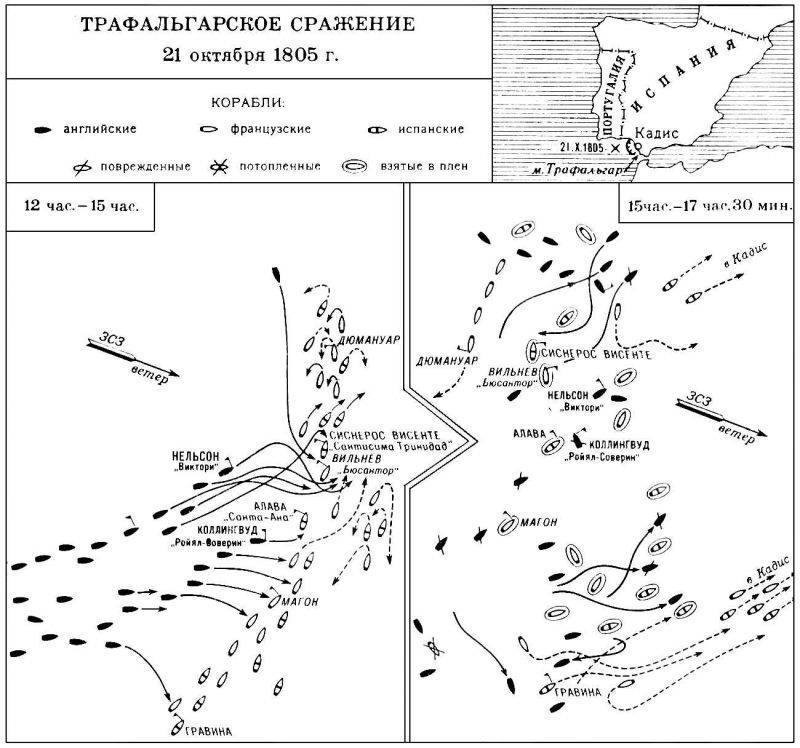
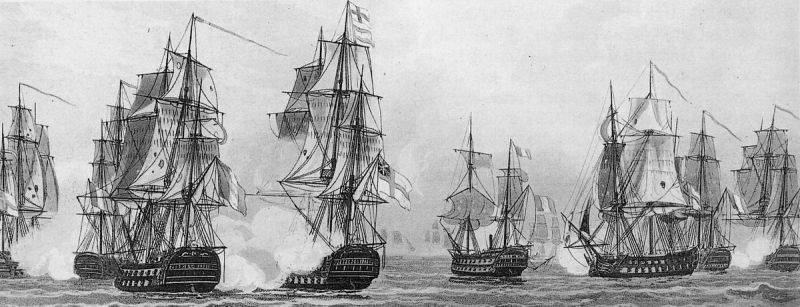
Information